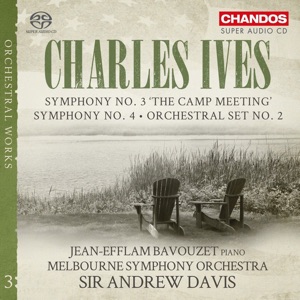This very generous program upholds the high standards that Andrew Davis and the Melbourne Symphony Orchestra have established thus far in their survey of Ives’ orchestral works. The Second Orchestral Set isn’t as popular as the First, perhaps because it lacks an evocative title. Orchestral Set No. 1, of course, is better known as “Three Places in New England,” but the Second Set is just as evocative, and I personally prefer it much of the time both for its wonderfully dark and dreamy opening movement, as well as for the extraordinary, dissonant climax of the finale (“From Hanover Square North, At the End of a Tragic Day, the Voice of the People Again Arose”).
Or maybe it’s just because I used to work in a building on Hanover Square (in downtown Manhattan), which is a few short blocks away from Ives’ own office on Ann Street. In any event, this performance is excellent in every way. You might call is “brazenly flowing,” in that it moves with a genuine sense of inevitability, without stinting on the more gutsy bits.
The Third Symphony, as well all know, lacks what you might call the “gutsy bits,” but this interpretation has that same sense of flow that the music demands, and sometimes doesn’t get. The finale is particular effective, a reminder that music based on hymn tunes doesn’t need to sound static and dull.
The performance of the Fourth Symphony is interesting, and different. It uses Thomas Brodhead’s performance score, which is in turn based on the recently published Critical Edition. Now the object of that Critical Edition was to preserve the work exactly as Ives left it, that is, all but unplayable; and so Brodhead, who worked on the CE, made this version as well. The main differences–as you might expect– occur in the crazy second movement, and to some degree in the fourth. Brodhead seems to have isolated specific melodic strands in the texture and, whether by design or engineering, given greater prominence to the solo piano (here played by the estimable Jean-Efflam Bavouzet).
The result may remind you of Messiaen’s Turangalila-Symphonie as much as it does Ives, but the result is convincing and, I think, a legitimate realization of his intentions. The performance doesn’t pull any punches, which is all to the good, but as I just suggested I do wonder if the balances are entirely what Brodhead (or Ives) always had in mind. If so, it’s a minor blemish on what is otherwise a wholly admirable release.
































